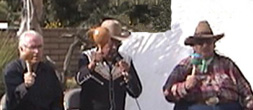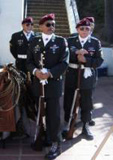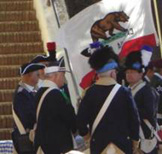San Diego Presidio Plaque Dedication
By Roy Cook
Tribal people are
forever, first and foremost, First Americans. Historically, California
Tribal people have paid their ‘fair share’ and nations more!
These are fine thoughts for Friday, November 4, 2005. The day is fair
and friendly for the festivities and recognition of “one peso from
each Indian, donation.” at the San Diego Presidio Plaque dedication.
The California Society of the Sons of the American Revolution organized this dedication. This group and organizations like the California Historical Society and San Diego Historical Society continue to thrive - there are currently five hundred additional small, volunteer-based historical societies throughout California, representing a vast number of nationalistic restoration projects.
 Firstly,
the Wildcat Singers open the dedication. Jon Meza Cuero, Tipai-Kumeyaay,
is a Master singer, native speaker, and culture bearer with a lifetime
of traditional experience in Southern California and Baja tribal communities.
Singing with him today are Ben Nance, Henry Mendibles and Roy Cook. Jon
sings Nyemie, Wildcat or Gato songs. Jon has taught language and music
classes on the college level for a number of years. He has organized the
‘Three Aukas’ singing group on both sides of the International
border to maintain and preserve the rich singing tradition of the Tipai
Kumeyaay Wildcat song.
Firstly,
the Wildcat Singers open the dedication. Jon Meza Cuero, Tipai-Kumeyaay,
is a Master singer, native speaker, and culture bearer with a lifetime
of traditional experience in Southern California and Baja tribal communities.
Singing with him today are Ben Nance, Henry Mendibles and Roy Cook. Jon
sings Nyemie, Wildcat or Gato songs. Jon has taught language and music
classes on the college level for a number of years. He has organized the
‘Three Aukas’ singing group on both sides of the International
border to maintain and preserve the rich singing tradition of the Tipai
Kumeyaay Wildcat song.
The Kumeyaay - Tipai people are the original guardians of the Bird song tradition. These songs are composed of an allegorical cycle of approximately 300 pieces. However, what we now generally call 'bird songs' was only one of twelve or more specialized song cycles, such as: Wildcat, Lightning, Salt dances, and Lasha and funeral songs.
Abel Silvas, Acjachemen
'Running Grunion', is the invited Native American Representative. Abel
is a Native American/Californio, whose ancestry comes from the Juaneno
Band of Mission Indians of the Acjachemen Nation and he is a direct descendant
from the Silvas Family, one of the first European families to settle in
California.
Of special
note is his link regarding many of the San Diego 'Old Town' historic buildings.
Jose Miguel Silvas was at the original presidio who brought the rest of
his family with Anza's exposition in 1775. He died in 1789 and is buried
at the presidio in an unmarked grave. His son, José Manuel Silvas,
at the beginning of the Mexican Period of San Diego was one of the first
to come down from the presidio in 1821 to build his garden and home site
along the San Diego River. This location is now unfortunately covered
over with the McCoy house. Further, Abel affirms the Juaneno Tribal presence
and contributions to earliest American history.
The California Society
of the Sons of the American Revolution dedicate a brass plaque recognizing
the financial contributions made by Spain in its war against Great Britain.
The National Society of the Sons of the American Revolution (NSSAR) recognizes
the Spanish Presidios in California at San Diego, Monterey, Santa Barbara,
and San Francisco as U. S. historical Revolutionary war sites. These four
California Presidios were included in the royal orders of King Carlos
III of Spain.
 With
patriotic flourishes and colorful colonial period reenactments the afternoon
program took place under sunny skies and a cool sea breeze. Indian summer
in San Diego is a beautiful place to be! A heroic military highlight is
the All American 82nd Airborne Veterans color guard.
With
patriotic flourishes and colorful colonial period reenactments the afternoon
program took place under sunny skies and a cool sea breeze. Indian summer
in San Diego is a beautiful place to be! A heroic military highlight is
the All American 82nd Airborne Veterans color guard.
Finally, with the echoes of muskets in the air, the Wildcat Singers conclude the main program with appropriate Kumeyaay songs.
Historical Background: Soon after King Carlos III declared War on England
in support of the American Revolution on June 21, 1779, Commandante General
Teodoro de Croix of the Provinces of  Northwest
New Spain expressed concern for the safety of the Presidio horse herds
to Governor Felipe de Neva of California. On August 17, 1780 King Carlos,
III, requested a one-time, voluntary donation of two pesos from each Spaniard
in missions of Alta California and one peso from each Indian. The Missions
and Presidios raised 2,683 Spanish silver dollars for the American Revolution.
It is not clear how this money was transmitted to the Americans; however,
it is known that Spain provided substantial financial support of the Americans
during the period of the American Revolution.
Northwest
New Spain expressed concern for the safety of the Presidio horse herds
to Governor Felipe de Neva of California. On August 17, 1780 King Carlos,
III, requested a one-time, voluntary donation of two pesos from each Spaniard
in missions of Alta California and one peso from each Indian. The Missions
and Presidios raised 2,683 Spanish silver dollars for the American Revolution.
It is not clear how this money was transmitted to the Americans; however,
it is known that Spain provided substantial financial support of the Americans
during the period of the American Revolution.
If you want additional information about the plaque dedication, or wish to participate in the planning or funding of a future plaque dedication, please contact the Chapter President, William E. Tisch (tis346@cox.net) or Chapter Secretary Philip L. Hinshaw (philiphinshaw@cox.net).
Tribal Reflections
respectfully reported by americanindiansource.com
Roy Cook: Writer, speaker, singer, curator (Opata-Oodham)